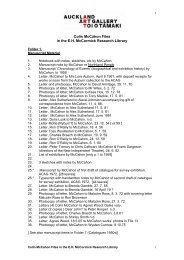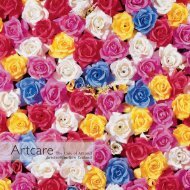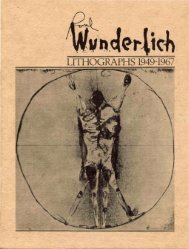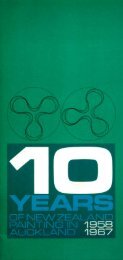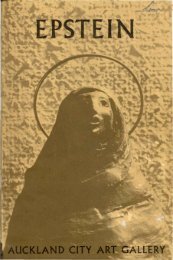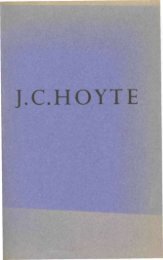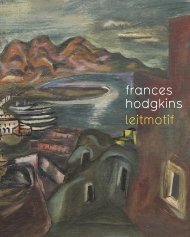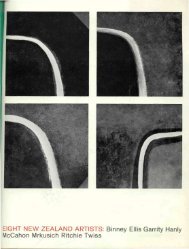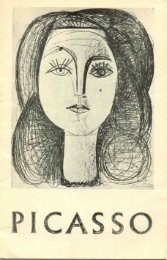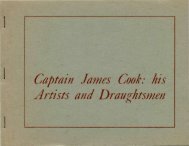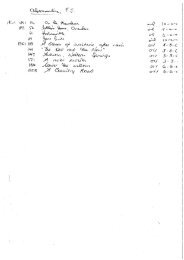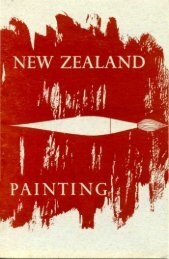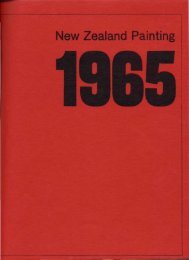the catalogue - Auckland Art Gallery
the catalogue - Auckland Art Gallery
the catalogue - Auckland Art Gallery
Create successful ePaper yourself
Turn your PDF publications into a flip-book with our unique Google optimized e-Paper software.
FOREWORDThis exhibition has been arranged for us by Mr Rex Nan Kivell,to whom we are most grateful.We must also thank him for allowing us to reprint Mr DenysSutton's introduction to <strong>the</strong> Redfern <strong>Gallery</strong> <strong>catalogue</strong> of a similargroup of paintings in 1957.<strong>Auckland</strong> City <strong>Art</strong> <strong>Gallery</strong>P. A. TOMORYMay, 1958RODGER HILTON Composition in Grey (37)
PREFACE BY DENYS SUTTONThe widespread passion for ' modern ' art in all its phases, socharacteristic of <strong>the</strong> years since <strong>the</strong> end of <strong>the</strong> war, has coincidedwith <strong>the</strong> emergence both in Britain and abroad of painters who,regardless of <strong>the</strong> consequences, are eager to press ahead intolittle charted territories. Such activity can be construed as a signof post-war restlessness or as <strong>the</strong> consequence of a desire at onceoptimistic and positive to make one's mark in one's own time,for better or for worse.What is more, it is no longer necessary to confess, as was <strong>the</strong>case some twenty years ago, that <strong>the</strong> English artist is averse toexperiment. To look at <strong>the</strong> contemporary school in Britain, infact, is to be made aware of <strong>the</strong> variety of trends that exist,ranging from Realism to Constructivism or Action painting.Never<strong>the</strong>less to suggest, as is sometimes done, that only onestyle is valid at any given period to <strong>the</strong> exclusion of all o<strong>the</strong>rs,is to run counter to <strong>the</strong> lessons of history: diversity and complexityare as essential to art as to life or to politics. Then, too, paintersmay enjoy quite distinct enthusiasms at each stage in <strong>the</strong>ircareers: many can, and indeed do, move between such oppositepoles as Realism and Abstraction. This is certainly true of someof those who appear in this exhibition.The extent to which several of <strong>the</strong>se artists are <strong>the</strong> originatorsof <strong>the</strong> particular styles which <strong>the</strong>y now practise, or how far <strong>the</strong>ydepend on <strong>the</strong> example of <strong>the</strong>ir colleagues, here or elsewhere,is not merely of academic interest; but whatever may be <strong>the</strong>solution to such problems is does not detract, on <strong>the</strong> whole, from<strong>the</strong> calibre of <strong>the</strong>ir contributions.The common denominator that relates <strong>the</strong>m, moreover, is notadherence to one single creed; to say of <strong>the</strong>m — as we could, forinstance of <strong>the</strong> Fauves or Cubists — that <strong>the</strong>y share an aes<strong>the</strong>tic,is not true. There is a very clear distinction between <strong>the</strong> ma<strong>the</strong>maticallyprecise ' architecture ' of Constructivism and <strong>the</strong> lyricalemotionalism of ' Tachisme.' All <strong>the</strong> same, <strong>the</strong>se artists are boundby <strong>the</strong>ir refusal to be slaves of <strong>the</strong> object. But if some are preparedto divorce <strong>the</strong>ir achievements from <strong>the</strong> observation ofobjects, in one way or ano<strong>the</strong>r, <strong>the</strong>ir apprehension of <strong>the</strong> world,whe<strong>the</strong>r that of external life or of <strong>the</strong>ir own imagination, directs<strong>the</strong>ir vision; and one might suggest that <strong>the</strong>ir experience of lifeis <strong>the</strong> necessary force that imparts shape to what <strong>the</strong>y produce.They paint <strong>the</strong> way <strong>the</strong>y do because <strong>the</strong>re is no alternative; <strong>the</strong>yclaim such freedom, one supposes, with a due recognition of <strong>the</strong>challenge, as well as <strong>the</strong> dangers, involved; <strong>the</strong>y explore, rejectond even head for blind alleys.Action painting — <strong>the</strong> hybrid child of <strong>the</strong> Frenchman Dubuffet,<strong>the</strong> German Ernst, <strong>the</strong> American Jackson Pollock — has now becomean international style, susceptible of different interpretationsat <strong>the</strong> hands of each of its practitioners. This approach from its
very nature places <strong>the</strong> responsibility on <strong>the</strong> artist's own shoulders:that shipwrecks at times occur is perhaps inevitable. Yet <strong>the</strong>liberty contained in this manner permits <strong>the</strong> artist, if so inclined,1o revel in his attack on <strong>the</strong> canvas and to move his paint as freewill and <strong>the</strong> unconscious dictate. Yet what is often noticeable isthat <strong>the</strong> result succeeds in achieving what one would imagine tobe unobtainable; <strong>the</strong> realisation of an organic whole.It may well be that <strong>the</strong> painter's determination to discover afresh vision — a spur that has directed artists at all times — carrieswith it certain precise, if at times almost unconscious safeguards.His painting becomes nothing less than a search to find in <strong>the</strong>incoherence of <strong>the</strong> swirling movements of ideas and sensationsthat form part of human nature, a logic that is perceived in <strong>the</strong>last analysis by means of ratiocination. The power of decisionand of selection or rejection occurs, not at <strong>the</strong> outset, when <strong>the</strong>canvas is being, so to say, plotted, but at <strong>the</strong> end, when <strong>the</strong>discoveries of <strong>the</strong> artist's impulses are laid out; <strong>the</strong>n a fashioningof <strong>the</strong> material comes into play and <strong>the</strong> result is one that canconform to <strong>the</strong> demands of <strong>the</strong> picture space itself. Even at <strong>the</strong>height of a process which when one considers it in cold blood tosmack of ' rock and roll,' <strong>the</strong> artist's sense for colour and formintervenes decisively.Action painting, which is <strong>the</strong> most ' novel ' of <strong>the</strong> tendenciesshown in this exhibition, from a national point of view, can claimto a respectable origin. Think only of Alexander Cozens (c. 1717-1786), <strong>the</strong> champion of <strong>the</strong> famous <strong>the</strong>ory of <strong>the</strong> ' blot.' Also, ofcourse, <strong>the</strong> Action painter is one of <strong>the</strong> upholders of an aristocraticpoint of view; his painting is <strong>the</strong> offspring of an attitude ofmind that refuses to believe, as far as art is concerned, in equalitarianconcepts. He asks of <strong>the</strong> spectator that he must enter a' Jardin d'Amour' in which <strong>the</strong> conventions established are thoseprovided by his own imagination. We can accept or reject, as wethink fit.Such painting, <strong>the</strong>n, refuses to come to terms with life as weknow it; it shows us a way into a different sort of life. In itsessence, it is a world in which <strong>the</strong> appeal is directly to <strong>the</strong> eyeend to <strong>the</strong> fancy; colours, internal rhythms, echoes from <strong>the</strong> pastsuch as touches of gold (that hark back to <strong>the</strong> Middle Ages andto Byzantium) are present in order to seduce us by <strong>the</strong>ir visualappeal. As for <strong>the</strong> meaning, what, in any case, do we knowabout meaning: is an egg an egg when it forms part of ancmelette? — a philosopher once asked. What is <strong>the</strong> message insuch painting, or is <strong>the</strong>re none? Is it that of Hedonism or of aDanse Macabre? Are we confronted with <strong>the</strong> tail end of civilisation,going out with a bang, or with <strong>the</strong> lifting of <strong>the</strong> curtain ona new performance — possibly no more than a one-act play?Yet as we see it today, Action painting, vivid, dazzling, amusing,teasing often, possesses one single and irresistible quality: that oflife-enhancement.
ADRIAN HEATH Composition, Red and Black (31)THECATALOGUEGILLIAN AYRES1 Black, Brown, Yellow Fusion2 Red Fusion12 1/2 x 483 Ochre Fusion24x724 Tachiste Painting36 x 10Dimensions are given in inches, height before width
SANDRA BLOW5 Painting, White and Red36x48DENISBOWEN6 Atomic Image, Black and Red541/2 x 307 Explosive Image32x568 Atomic Image, Black, Red and White201/4 x 24 1/49 Atomic Image, Red and White46 1/4x43HENRY CLIFFE10 Landscape, late Evening18 x 14 1/4 Signed H. Cliffe '561 1 Painting, Blue and Yellow14x 16 3/4BERNARD COHEN12 Objects, 1957, I32x28HAROLD COHEN13 Garden VII, Autumn30x28JOHNCOPLANS14 Open Forms I39x3015 Open Forms II30x3916 Open Forms III54x30PETERCOVIELLO17 Head Image36x2818 Rose Emergence391/2 x 29 3/419 Red Head Image29 1/2 xl93/4ALAN DAVIE20 Flag Dream II (Punch)48x60
ROBYN DENNY21 Painting 195738 x 28 Signed Denny '57PAUL FEILER22 Summer44x6023 Porthledden Black14 x 18 Signed Feiler 5624 Landscape and Sea31 x47DONALD HAMILTONFRASER25 Blue Sea Coast with Distress Rockets36x28TERRYFROST26 Abstract, Blue, Red and White551 x 4827 Head24x15WILLIAMGEAR28 Red and Yellow13 x 18 1/429 Study with Blue and Orange18x21 1/230 Red Preserve, May 195732x43ADRIAN HEATH31 Composition, Red and Black33 1/2x23 1/232 Painting, Yellow and Grey36x3033 Painting, Red and Black48x50 ~PATRICKHERON34 Autumn Garden72x3635 Summer Painting72 1/4 x 3636 Tulip Garden36 x 15
ROGER HILTON37 Composition in Grey20x24JAMES HULL38 Painting, Black and Yellow on White301/2 x 48GWYTHER IRWIN39 Insect Form30 1/4 x 46 1/440 Bosky Glade191/2 x2841 Gun III24x36 Signed IrwinLOUIS JAMES42 The Approaching Night40 x 20 Signed Louis James43 Acacia Trees III39 1/2 x 79 1/2 Signed Louis James44 The Garden50 x 24 1/4 Signed Louis JamesPETER KINLEY45 Painting, Blue and Black50 1/4x25 1/4PETER LANYON46 Trencrom Hill37x24DEREK MIDDLETON47 Blue Painting28x3648 Water Reflections20 1/4x 29 3/449 Objects Submerged49 3/4 x 36J. MILNES-SMITH50 Ochre and Brown Painting24 1/2 x 3151 Red, Blue and White Painting24x19 3/452 Composition Landscape23x328
HENRY MUNDY53 Blue Atmospherics20x24RODRIGO MOYNIHAN54 Painting, Red and Violet361/2 x 2855 Painting, Vertical19 3/4 x 5056 Painting, Green and Grey16x20 1/4VICTOR PASMORE57 Spiral I24x8 3/458 Spiral II24 x 12RALPH RUMNEY59 Tachiste Painting I48x4860 Tachiste Painting II48 x4861 Tachiste Painting III30 1/4 x21 1/462 Tachiste Painting IV63x60FRANK AVRAY WILSON63 Red Configuration351/4 x 35 1/464 Yellow Configuration36x3665 Black, Red, Blue Configuration66x4066 Mauve, Yellow Configuration72x2467 Horizontal Forms22 1/4 x 30BRYAN WYNTER68 High Country60x4069 Impenetrable Country8x4070 Sunken World30x24
T H EP A I N T E R SGILLIAN AYRESBorn in Barnes, England, 1930. Educated at St Paul's School.Camberwell School of <strong>Art</strong>, 1946 to 1950. Exhibited in LondonGroup since 1951. Group Show in A I A <strong>Gallery</strong>, 1954. One-manshow <strong>Gallery</strong> One, 1956. Oslo, 1957. Also shown in mixed exhibitionsat <strong>the</strong> Redfern, New Vision and Leicester Galleries.SANDRA BLOWBorn in London, 1925. Studied at St Martin's School of <strong>Art</strong> andRoyal Academy. Exhibited at Royal Academy, 1946, 1947. Exhibitedgroup shows: I C A December, 1950; Gimpel Fils, 1951;Galerie Origin!, Rome, 1952; Oxford, Blackhall St Giles, 1952;Tate <strong>Gallery</strong>, 'Figures in Their Setting,' 1953. One-man shows:Gimpel Fils, 1952 and 1954; Exhibition at <strong>the</strong> Saidenberg <strong>Gallery</strong>,New York, January, 1957.DENIS BOWENBorn 1921 in Kimberley, South Africa. Studied at HuddersfieldSchool of <strong>Art</strong>. 1949 received Diploma in painting at <strong>the</strong> RoyalCollege of <strong>Art</strong>. Founded New Vision Group, 1955. Instructor inTheory of Design at Central School of <strong>Art</strong>, Hammersmith Schoolof <strong>Art</strong> and London School of Printing and Graphic <strong>Art</strong>. Exhibitedat Galerie Creuze, Paris; New Vision Centre; London Group andin Serigraphic Exhibition at <strong>the</strong> I C A, 1957.II
HENRY CLIFFEBorn at Scarborough, Yorks, 1919. Studied at ScarboroughSchool of <strong>Art</strong> and Bath Academy School of <strong>Art</strong>, Wiltshire. Exhibitedat Cincinatfi Biennial of Colour Lithography in 1952, 1954,1956, and also British Pavilion at Venice Biennale, 1954. EngelskeOriginallithografier, Scandinavia, 1956. Mixed shows at <strong>the</strong> Redfern<strong>Gallery</strong>, 1954, 1955, 1956. Exhibitor, London Group. Firstone-man show, Redfern <strong>Gallery</strong>, 1956. Teaches painting andlithography, Bath Academy of <strong>Art</strong>, Corsham, Wilts.BERNARD COHENBorn in London in 1933. Studied at St Martin's School and <strong>the</strong>Slade School of <strong>Art</strong>. Has exhibited at Gimpel Fils since 1953, andat <strong>the</strong> Redfern <strong>Gallery</strong>.HAROLD COHENBorn 1928. Studied at <strong>the</strong> Slade School of <strong>Art</strong>, 1948-1952. WonAbbey Minor Scholarship, 1952. Held his first one-man show in1950 at <strong>the</strong> Ashmolean Museum, Oxford, and his second onemanshow in 1954 at Gimpel Fils, London. Represented in <strong>the</strong><strong>Art</strong>s Council Collection. Designs and makes furniture.JOHN COPLANSBorn in 1920, London. Mainly self-taught. Exhibited R B A, 1950;London Group, 1954; <strong>the</strong> 1C A and <strong>the</strong> Redfern <strong>Gallery</strong>, 1956;New Vision and Volkerkunde Museum, Munich, 1957.PETER COVIELLOBorn in London in 1930. Studied at Willesden and Guildford artschools from 1947 to 1952. Served in <strong>the</strong> RAF. Has exhibitedwith Young Contemporaries, 1951-1952; at <strong>the</strong> Royal Academy,1952-1953; 1C A 'Five Young Painters,' 1958; Redfern <strong>Gallery</strong>,'Christian Vision,' 1958.ALAN DAVIEBorn in Scotland, 1920. Awarded <strong>the</strong> Andrew Grant Scholarship,Edinburgh, 1938; <strong>the</strong> Edinburgh College of <strong>Art</strong> Diploma, 1940;<strong>the</strong> Andrew Grant Travelling Scholarship, 1940. Served with <strong>the</strong>Royal <strong>Art</strong>illery, 1940-1946. Received Guthrie Award, R S A, 1941.Held one-man shows in Edinburgh, 1946; Florence and Venice in1948, and several at Gimpel Fils between 1950 and 1956. Hasbeen included in exhibitions shown in Mexico, New York, Rome,Brussels, <strong>the</strong> British Council's Scandinavian Show of British <strong>Art</strong>and <strong>the</strong> Critic's Choice Exhibition, London, 1956. One paintingwas amongst five chosen by <strong>the</strong> National Jury to go forward forconsideration at <strong>the</strong> Guggenheim International Award in Painting,1956. Works have been bought by <strong>the</strong> Museum of Modern <strong>Art</strong>;Guggenheim Foundation; Albright Museum, Buffalo, and <strong>the</strong>Contemporary <strong>Art</strong> Society, London.12
ROBYN DENNYBorn in Surrey in 1930. Educated Clayesmore School. Royal Navy1949-1951. Studied at St Martin's School of <strong>Art</strong>, 1951-1953.RCA, 1954-1957. Exhibited 'Young Contemporaries/ 1953,1954, 1956, 1957. Visual <strong>Art</strong>s Exhibition, Leeds, 1953.PAUL FEILERBorn in 1918. Studied at <strong>the</strong> Slade. One-man shows at <strong>the</strong>Redfern <strong>Gallery</strong>, 1953, 1954, 1956. Also one-man show at <strong>the</strong>Obelisk <strong>Gallery</strong>, Washington, 1953.DONALD HAMILTON FRASERBorn London, 1929. Studied at St Martin's School of <strong>Art</strong>, 1949-1953. Awarded French Government Scholarship, 1953-1954.Exhibited one-man shows at Gimpel Fils, 1953, 1956; Paris, 1956.Included in Critic's Choice Exhibition, 1955; Six Young BritishPainters, Oxford, 1956; Tate <strong>Gallery</strong> CAS Exhibitions, 1952,1953, 1956. Daily Express 'Young Painters' prizewinner, 1955;British Painting, Whitechapel <strong>Gallery</strong>, 1954; British RomanticFainting in <strong>the</strong> Twentieth Century, <strong>Art</strong>s Council, 1953.TERRY FROSTBorn in Leamington Spa, 1915. Studied at Camberwell School of<strong>Art</strong> and in Cornwall. One-man shows at Leicester Galleries, 1952,1956. Exhibited at Pittsburgh Biennale, 1956; Oslo, Copenhagenand Canada, 1956; Tokyo Biennale, 1957.WILLIAM GEARBorn in Scotland, 1915. Studied at Edinburgh College of <strong>Art</strong>,1932-1937. Received Diploma of <strong>Art</strong>, 1936. Travelled in Europewith scholarship 1938-1939. Worked in Paris, 1947-1950. Memberof London Group. One-man exhibitions: Florence, 1944; Hamburg,1947; Paris, 1948; New York, 1949, 1957; London (GimpelFils), 1948, 1949, 1951, 1953, 1956; South London <strong>Art</strong> <strong>Gallery</strong>,1954.ADRIAN HEATHEorn in Burma, 1920. First painted in Newlyn, Cornwall, underStanhope Forbes, R A, and in 1939 at <strong>the</strong> Slade School, Oxford.First abstract painting shown at <strong>the</strong> London Group, 1949. In1953, held first one-man show at <strong>the</strong> Redfern <strong>Gallery</strong>. Exhibitionsat Roland, Browse & Delbanco, Gimpel Fils and <strong>the</strong> Redfern<strong>Gallery</strong>.PATRICK HERONBorn 1920. Exhibited Redfern <strong>Gallery</strong>, 1947, 1948, 1950, 1951,1954 and 1956. Also exhibited in Denmark, Norway, Sweden,Paris, Venezuela, USA and Canada. Exhibited twelve paintingsat 2nd Bienal at Sao Paulo, Brazil, 1953. <strong>Art</strong> Critic of <strong>the</strong> NewStatesman and Nation from 1947 to 1950. Published TheChanging Forms of <strong>Art</strong>, 1955.13
ROGER HILTONBorn in Middlesex, 1911. Studied at <strong>the</strong> Slade School of <strong>Art</strong>,London. Awarded a scholarship and an Orpen Bursary. Studiedin Paris at <strong>the</strong> Academie Ranson under Bissiere. Had a show at<strong>the</strong> Bloomsbury <strong>Gallery</strong>, 1937, and Gimpel Fils, 1952. His workhas been included in exhibitions at <strong>the</strong> Tate <strong>Gallery</strong>, ' 17Collectors/ 1952, and 'Figures in Their Setting/ 1953. Also'Contemporary British <strong>Art</strong>/ Paris, 1952, and 'Recent BritishPainting' (<strong>Art</strong>s Council, 1954).JAMES HULLBorn in 1921. Studied architecture from 1936 to 1939 followedby war service 1939-1945. Has painted since 1928. One-manexhibitions have been held yearly since 1948 in London (BrookStreet <strong>Gallery</strong>, Gimpel Fils), Paris, New York, Brooklyn andMunich.GWYTHER IRWINBorn in Basingstoke, 1931. Trained at Goldsmiths <strong>Art</strong> School,1951-1952; Textile design at <strong>the</strong> Central School of <strong>Art</strong>, 1952-1955. Exhibited with Young Contemporaries, 1953, also <strong>Art</strong>istsUnder Thirty-five, 1955. One-man show at <strong>Gallery</strong> One, 1957.LOUIS JAMESBorn in Adelaide, South Australia, 1920. Served in <strong>the</strong> Infantry1940-1944. Went to live in England in 1949. Had one-man showin Adelaide in 1949 and exhibited in most Australian capitalcities, as well as in Washington, USA, Dublin, Belgium, andEngland. In London he has exhibited at <strong>the</strong> Redfern <strong>Gallery</strong>;Roland, Browse & Delbanco; Ohana <strong>Gallery</strong>; A I A <strong>Gallery</strong>; <strong>the</strong>New Vision <strong>Gallery</strong>, and with <strong>the</strong> London Group.PETER KINLEYBorn 1926. Served in <strong>the</strong> Army 1944-1948. Studied at St Martin'sSchool of <strong>Art</strong>, London, 1949-1953. Has taken part in <strong>the</strong> followinggroup shows: Young Contemporaries, 1951, 1952, 1953.PETER LANYONBorn at St Ives in 1918. Trained at Penzance and Euston RoadSchools. Teaches painting at Bath Academy of <strong>Art</strong>; Joint Principal,St Peter's Loft School of <strong>Art</strong>, St Ives. One-man shows atLefevre <strong>Gallery</strong>, 1949; Gimpel Fils, 1952 and 1954; Passedoit<strong>Gallery</strong>, New York, 1953. Exhibition at Ca<strong>the</strong>rine Viviano <strong>Gallery</strong>,New York, 1957.DEREK MIDDLETONBorn in 1917. Studied in Munich before <strong>the</strong> war. Largely selftaught.Exhibited in <strong>the</strong> Royal Academy, <strong>the</strong> London Group, <strong>the</strong>Parsons <strong>Gallery</strong> in a show called 'Six Young Painters' in 1955.Also in mixed exhibitions at <strong>the</strong> Redfern <strong>Gallery</strong>.14
J. MILNES-SMITHBorn in 1912. Trained and practising architect, A R I B A. Firstexhibition, ' British Abstract <strong>Art</strong>' at Gimpel Fils in 1951. Exhibitedsince at <strong>the</strong> Redfern <strong>Gallery</strong>, London Group, and o<strong>the</strong>r mixedexhibitions.RODRIGO MOYNIHANBorn in 1910 at Teneriffe, Canary Islands. Trained at art schoolsin Italy and at <strong>the</strong> Slade School. Member of London Group in1933. Group exhibition of Objective Abstractions in 1934. Onemanshows at <strong>the</strong> Redfern <strong>Gallery</strong>, 1940, 1943, and LeicesterGalleries, 1955. Teaches painting RCA since 1948. BecameA R A in 1944, and R A in 1953.HENRY MUNDYBorn in 1919 in Birkenhead, Cheshire. Studied at <strong>the</strong> Laird Schoolof <strong>Art</strong> <strong>the</strong>re. Served in <strong>the</strong> Army 1940-1946, <strong>the</strong>n studied at <strong>the</strong>Camberwell <strong>Art</strong> School for four years. Has exhibited at <strong>Gallery</strong>One, 1954 and 1956; Oslo, 1957; AIA <strong>Gallery</strong>; <strong>the</strong> Redfern<strong>Gallery</strong>, and with <strong>the</strong> London Group.VICTOR PASMOREBorn in 1908 in Surrey. Settled in London in 1927. Studied artprivately and at evening schools. Joined <strong>the</strong> London <strong>Art</strong>ists' Association,1931, and <strong>the</strong> London Group, 1932. Associated with <strong>the</strong>exhibition of Abstract <strong>Art</strong> at <strong>the</strong> AIA <strong>Gallery</strong> and 22 FitzroyStreet, 1951-1953, and <strong>the</strong> '<strong>Art</strong>ist Versus Machine' exhibitionat <strong>the</strong> Building Centre, 1954. Retrospective exhibitions at <strong>the</strong>I C A, 1954. Has held successive one-man shows at <strong>the</strong> Redfern<strong>Gallery</strong> since 1938. Appointed Master of Painting, DurhamUniversity, 1954.RALPH RUMNEYBorn at Newcastle-upon-Tyne in 1934. Lived in Cornwall, Paris,Sicily, from 1951 to 1955. Edited O<strong>the</strong>r Voices, 1955. One-manshow in Trieste, 1955, and Galleria Apollinaire, Milan, 1956 and1957. Four paintings in an international exhibition in Tokyo,1956. First London show at New Vision Centre <strong>Gallery</strong>, 1956.Exhibited in Galerie Taptoe, Brussels, 1957.FRANK AVRAY WILSONBorn in Mauritius, 1914. Has painted since childhood, studiedprivately in France before <strong>the</strong> war, concurrently with physiologyin Cambridge. Whole time painter since 1946. Studied in Norwayand has been a non-objective painter since 1951. One-man exhibitionat <strong>the</strong> Redfern <strong>Gallery</strong>, 1957.BRYAN WYNTERBorn in London, 1915. Studied at <strong>the</strong> Slade School of <strong>Art</strong>. Onemanexhibitions at <strong>the</strong> Redfern <strong>Gallery</strong>, 1947, 1948, 1950, 1953,1955 and 1957. Taught painting at Bath Academy of <strong>Art</strong>, 1951to 1956. Now works full time in Cornwall, where he has livedintermittently since 1945.15



